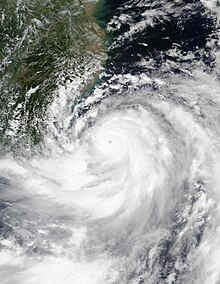 Gaemi at peak intensity while off the coast of Taiwan on July 24 | |
| Meteorological history | |
|---|---|
| Formed | July 19, 2024 |
| Dissipated | July 29, 2024 |
| Very strong typhoon | |
| 10-minute sustained (JMA) | |
| Highest winds | 165 km/h (105 mph) |
| Lowest pressure | 940 hPa (mbar); 27.76 inHg |
| Category 4-equivalent typhoon | |
| 1-minute sustained (SSHWS/JTWC) | |
| Highest winds | 230 km/h (145 mph) |
| Lowest pressure | 919 hPa (mbar); 27.14 inHg |
| Overall effects | |
| Fatalities | 126 confirmed |
| Injuries | 929 |
| Missing | 40 |
| Damage | $262 million (2024 USD) |
| Areas affected |
|
| IBTrACS | |
Part of the 2024 Pacific typhoon season | |
Typhoon Gaemi, known in the Philippines as Super Typhoon Carina, was a powerful and destructive tropical cyclone which impacted East China, Taiwan, and the Philippines in late July 2024. Gaemi, which means ant in Korean, the third named storm and second typhoon of the annual typhoon season, formed as a tropical depression east of Palau on July 19. Owing to favorable environmental conditions, the typhoon intensified and reached its peak with ten-minute maximum sustained winds of 165 km/h (105 mph), and a central atmospheric pressure of 940 hPa (27.76 inHg). With one-minute sustained winds at 230 km/h (145 mph), Gaemi was classified as a Category 4-equivalent typhoon. The storm then turned north-northwestward, along the western periphery of a subtropical ridge. After stalling and executing a tight counter-clockwise loop near the coast, Gaemi slightly weakened due to land interaction before making landfall on the northeastern coast of Taiwan on July 24. It emerged over the Taiwan Strait just six hours after landfall. Gaemi made landfall in China as a minimal tropical storm in the Xiuyu District of Putian in Fujian Province. Once inland, the system weakened to a tropical depression by July 27 and continued tracking the system until it dissipated on July 29.
Together with the southwest monsoon and Tropical Storm Prapiroon, heavy rains were reported over southern and northern Luzon, triggering widespread flash floods in various areas of the region. The monsoon enhanced by Gaemi's impact on Luzon led to comparisons to 2009's Typhoon Ketsana. The oil tanker MT Terra Nova, carrying around 1.5 million liters of industrial fuel, capsized and sank in 34 m (112 ft) depth of water in Manila Bay off the coast of Limay, Bataan. In Japan, the island of Yonaguni recorded wind speeds of up to 180 km/h (110 mph). In Indonesia, large waves of up to 2.5 m (8.2 ft) in height affected the Molucca Sea, North Natuna Sea, Natuna Sea, and the areas between the Sitaro Islands and Bitung, and between the Sangihe Islands and Talaud Islands. A maximum rainfall accumulation of 512.8 mm (20.19 in) was observed in Luoyuan County in Fujian Province. The remnants of Gaemi also hit North Korea, where up to 4,000 may have died. North Korean state media did provided figures on casualties. In all, the typhoon killed at least 126 people, injured 929 others, and caused US$304 million worth of damage.